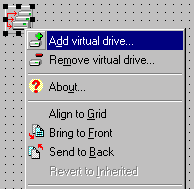Properties Methods



|
Properties Methods |



|
| The dcVirtualDrives component lets an application to define, redefine and delete the virtual drives in the file system.
|
|
|
| The Virtual Drives (also known as MS-DOS device names) is the symbolic links, in the object name space in 32-bit versions of Windows, which points to the directories of your existing drives (hard, floppy, CD and so on). The code that converts an MS-DOS path into a corresponding path in 32-bit versions of Windows uses these symbolic links to map the virtual devices and drive letters.
|
|
|
| The dcVirtualDrives can manage the virtual drives either at run- and design-time, on either Win9x or NT-family machines.
|
| The dcVirtualDrives component automatically detects available virtual drives and returns the drive names in the VirtualDrives property. To get the target directory of the virtual drive - specify the first letter of this drive in the Drive property, and get the path of target directory from Target property.
|
|
|
| To add the virtual drive to the file system, or redefine existing virtual drave to another target - use AddDrive method. To delete the virtual drive - use DeleteDrive method.
|
|
|
| The list of UnusedDrives is a good reference to give you an idea which drives are currently free and can be defined as virtual drive.
|
|
|
| To add the new virtual drive at design-time, click the right mouse button on the component image and select "Add virtual drive..." menu item.
|

|
| dcDiskInfo component;
|
|
|
| The demo application ("Virtual Drives Manager") at http://www.appcontrols.com/software/virtualdrives.html
|